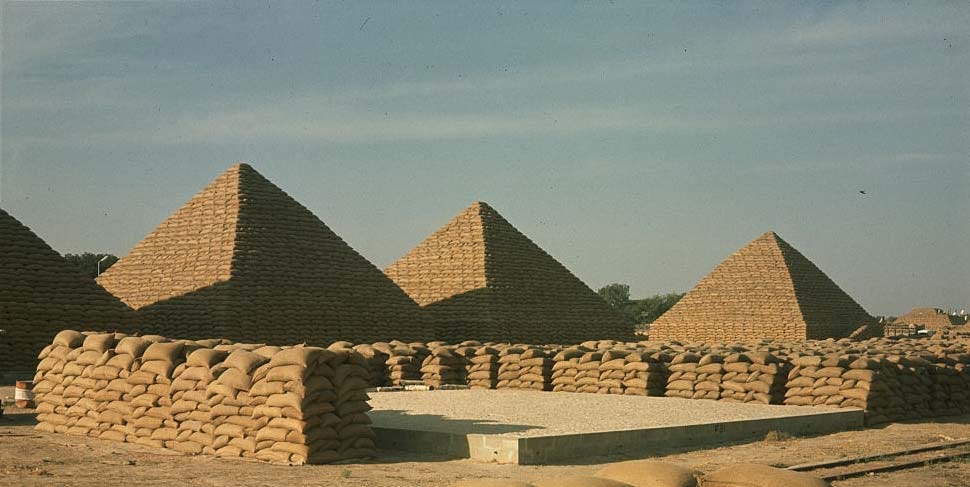Groundnut pyramids in Nigeria.If you were to produce a reel of how Agriculture contributes to the economy of Nigeria, the famous story of the groundnut pyramids would definitely take up a major part of that reel.While Sesamum seeds, Maize grains, cocoa...
 Groundnut pyramids in Nigeria.
Groundnut pyramids in Nigeria.If you were to produce a reel of how Agriculture contributes to the economy of Nigeria, the famous story of the groundnut pyramids would definitely take up a major part of that reel.
While Sesamum seeds, Maize grains, cocoa beans, or cashew nuts account for the Agriculture export revenue in Nigeria at the moment, groundnut accounted for 70 percent of Nigeria export revenue between the 1950s and 1960s.
For a long period, groundnut sustained the economy through revenue from exports to both foreign and local markets during the agricultural boom. The groundnut pyramids were the pillar of the Nigerian economy and they were also a spectacle as they towered high to a point higher than most buildings in Kano City.
In the 1980s, groundnut production in Nigeria nosedived and what was left of the famous Groundnut pyramids in Kano were only stories.
The big question is can groundnut production get to the level it used to be at? Will the pyramids be back? Dried groundnut pods. Source: Pexels
Dried groundnut pods. Source: PexelsGroundnut pyramids: The pillar of Nigeria’s economy.
Were they just for aesthetic purposes or was there an economic reason for them?To fully answer the question you have to first understand what the pyramids represented. The groundnut pyramids, a symbol of wealth and a tourist attraction, were erected in Kano, Nigeria by piling sacks of groundnuts on top of the other into pyramid-shaped structures.
In the 1960s and 1970s, groundnut production in Nigeria was at its peak. According to a study on the Regional Assessment of groundnut in Northern Nigeria, an estimated output of 500,000 metric tonnes yearly until its peak capacity of 1.6 million metric tonnes in 1973 prior to the oil boom which accounted for almost 41% of the total production in West Africa at the time Nigeria’s dominance in the production of groundnut dates back to the early 1900s. At the time, Agriculture was the major powerhouse driving Nigeria’s economy, so the government encouraged the cultivation of groundnut and other cash crops.
Alhassan Dantata was one of the major players in the Agriculture space in Nigeria who contributed to Nigeria’s dominance in groundnut production. He was also one of the drivers of the idea of the groundnut pyramids.
Dantata is someone you’ll refer to as an aggregator in the Agriculture value chain in modern times. (An aggregator is someone who accumulates produce in large volumes from farmers and then sells to make profit)
 Collection of Groundnut pods.
Collection of Groundnut pods.He had access to the markets outside Nigeria and he also had links to local farmers in Kano state and other states in Northern Nigeria where farmers predominantly produced groundnut. The bags of groundnuts accumulated from farmers were then piled to make a pyramid in Kano city. The pyramids made the aggregation and shipping process of groundnut easy from Kano to Lagos before they were then exported. Also, the method of stacking groundnut bags in a pyramid is a storage method to prevent the infestation of insects.
So the pyramids were made not just because they were beautiful, but because they also served as aggregation points and a single line of transportation for the movement of groundnuts.
Nigeria still stands as the largest producer of groundnut in Africa and the third largest in the world, coming after China and India. Nigeria currently produces about 2million MT accounting for 5% of the world’s production. However, the country does not export nearly that much.
Why did the Groundnut pyramids crash?
Many experts believe the shift from agriculture to oil as the major revenue generator between the 1960s and 1970s as the major export in Nigeria is the sole reason for the disappearance of the groundnut pyramids. While this is true, several environmental factors also contributed to the crash of the groundnut industry in Nigeria.
The groundnut pyramids thrived because of two major factors:The one channel marketing structure of groundnut in NigeriaReady market for groundnut sales The Groundnut Pyramids of Nigeria. Pic credit: AgroNigeria
The Groundnut Pyramids of Nigeria. Pic credit: AgroNigeriaAfter the exploration of oil became popular in Nigeria, the economy diversified and the focus shifted from Agriculture to crude oil. Crude oil became the new pillar that Nigeria’s economy relied on but instead of pyramids, you had barrels, oil wells and rigs. This caused a domino effect that resulted in the collapse of the structures that supported the groundnut industry. The final straw that broke the camel’s back was an outbreak of Aphids (pests) which was facilitated by the drought spells across farms in Nigeria. Aphids are carriers of the groundnut rosette virus and the outbreak of the pests made the virus spread like wildfire.
According to an article by Face 2 Face Africa, the Rosette virus epidemic in 1975 and subsequent viruses in 1983, 1985 and 1988 accounted for the loss of over 700 thousand hectares of groundnut in the region. The epidemic devastated the pyramids erected in Malam Madori, Jigawa State. These factors led to the gradual and eventual disappearance of Nigeria’s famous groundnut pyramids.
One other factor that contributed to the decline of the groundnut industry was rural urban migration. With the oil boom came diversification and creation of more jobs in Urban areas. Add that to the dwindling popularity of Agriculture as a viable means of earning income and what you get is an idea that Agriculture was not cool and ultimately migration from rural areas to urban areas. This was the final nail.
Read our article on how to make Agriculture cool for Africa’s young people
A lot of young people still have this bias and it is one we are always trying to change.
If not Groundnut, what then?
After the Rosette virus epidemic and losing thousands of hectares in yield, several farmers lost confidence in groundnut production and channelled their resources towards other agricultural crops like cocoa, cowpea, millet and sorghum. The present day agriculture industry in Nigeria still thrives but most people say it is a shadow of its former self. Although Nigeria still dominates the production and exportation of certain crops in Africa like ginger, maize and rice.
Groundnut pyramids: to be or ‘nut’ to be
After understanding why the pyramids existed in the first place one can conclude that there is no need for the pyramids in modern times. The players in the groundnut industry built the pyramids for 2 major purposes.
A means of storageAn easy means of transportation and aggregationThere are better storage methods now in modern times which cut down post-harvest losses. This makes the need to build groundnut pyramids for storage not entirely necessary. Also, there’s an increased demand for and diversified use of groundnut in production (like for oils and cake) and multiple channels of sales.
Will the pyramids ever return? Probably ‘nut’.
A prosperous Africa begins with you, let’s do more for our Farmers. Visit thriveagric.com to get started. Follow us on Twitter, Instagram, Facebook, LinkedIn and subscribe to our YouTube Channel to see our work improving the lives of local farmers in Nigeria and how we are building to ensure food security in Africa, one farmer at a time.
Groundnut production in Nigeria: Will the Groundnut pyramids of Kano be back? was originally published in Hectare on Medium, where people are continuing the conversation by highlighting and responding to this story.








